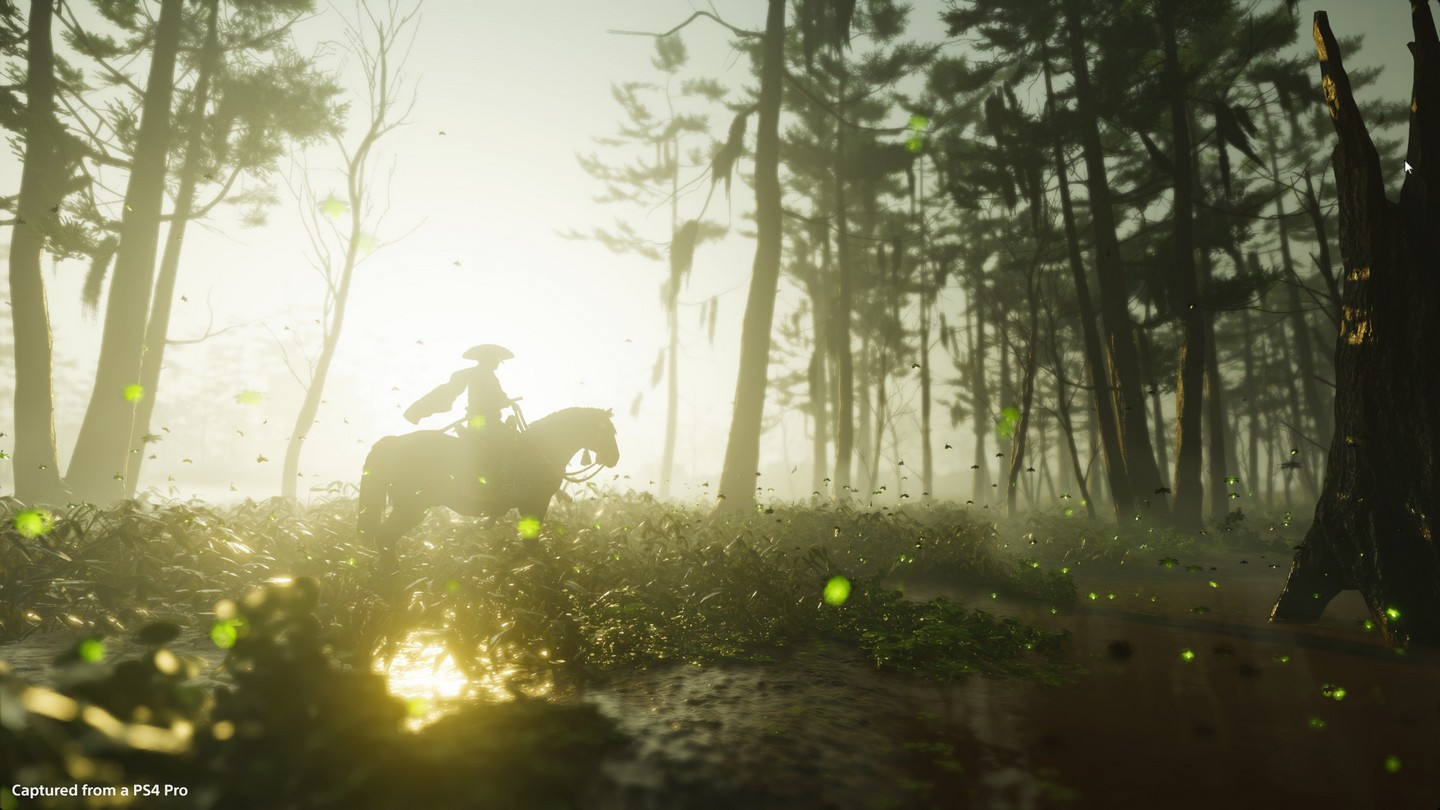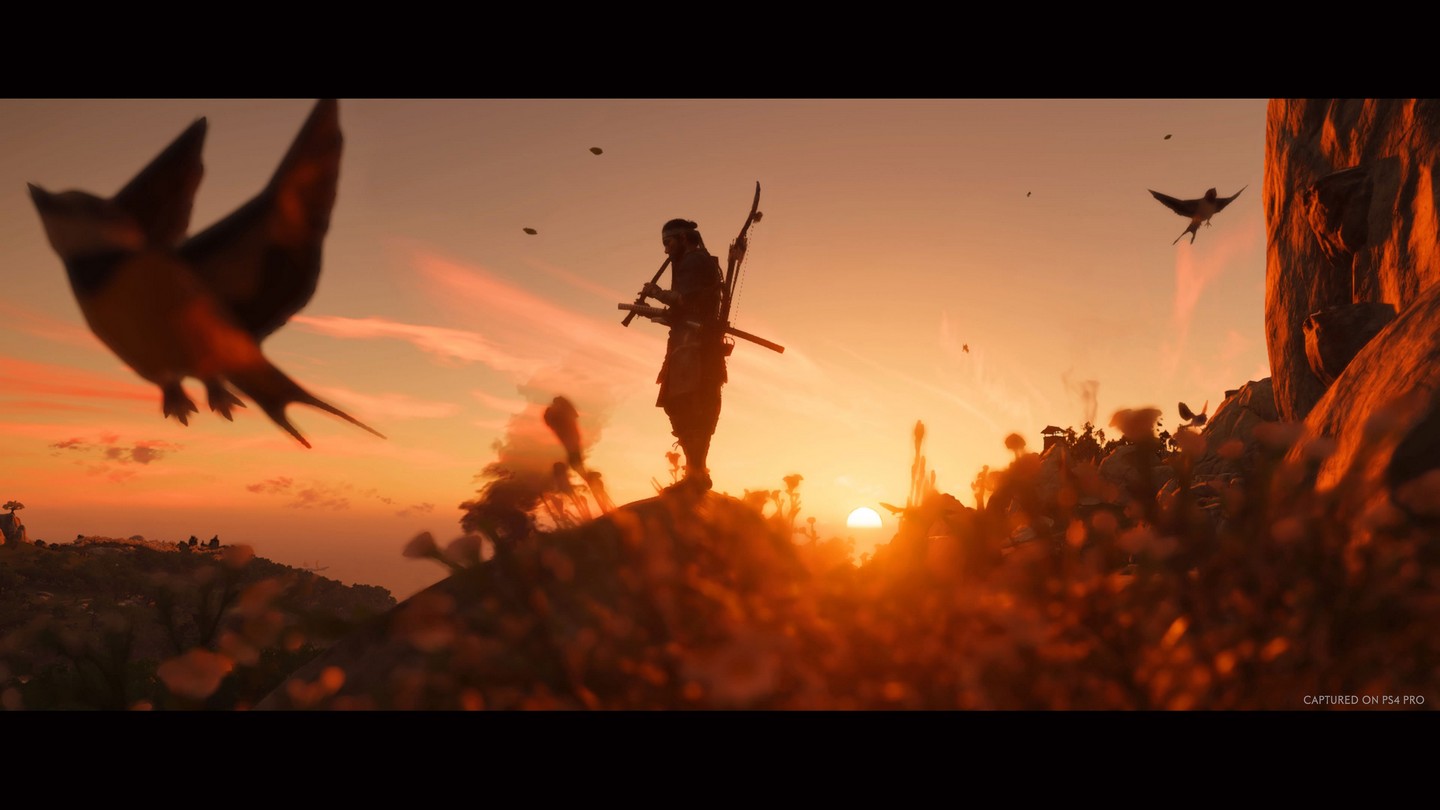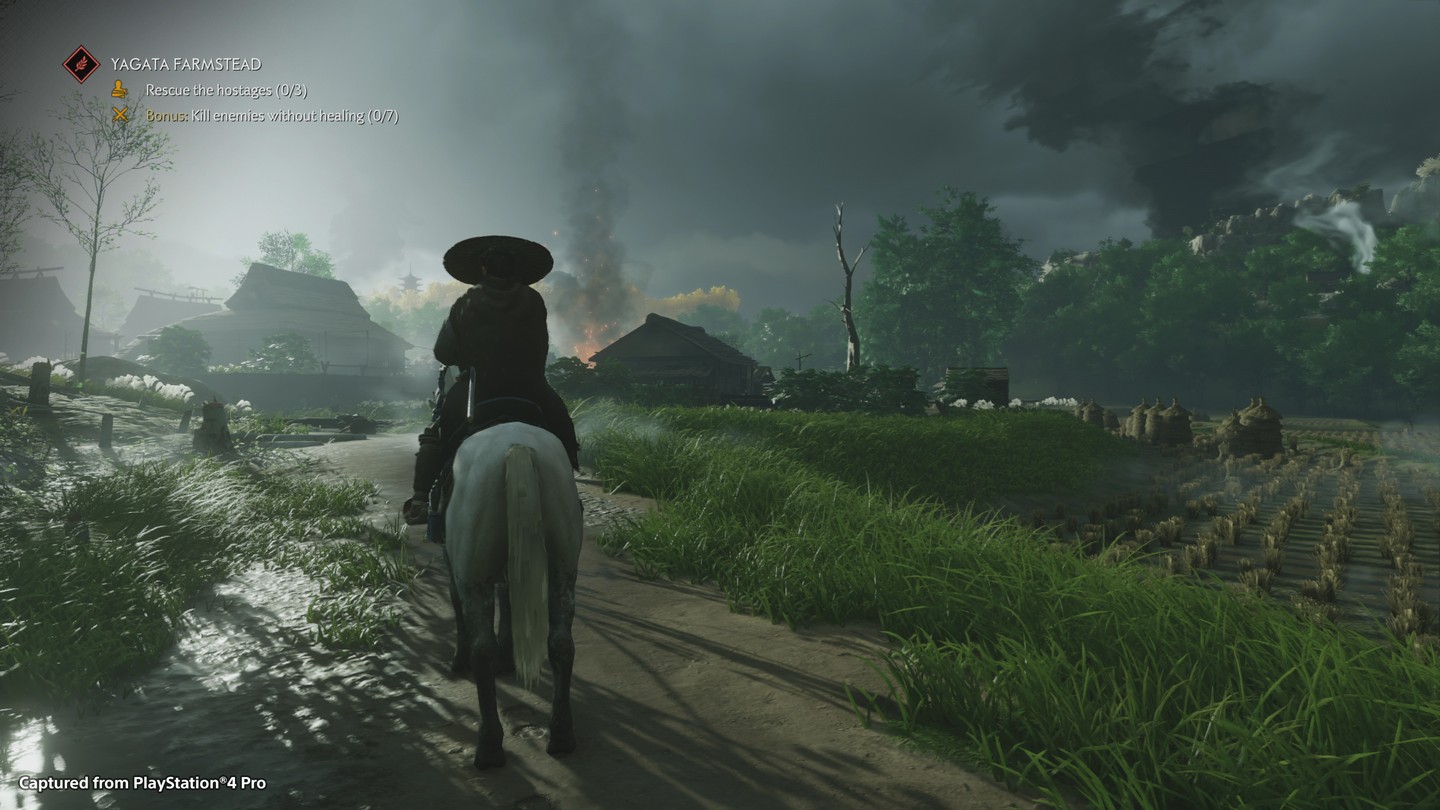For honor
The impermanence of life. The certainty of change. The balance between tradition and progress, and between honor and duty. Allof these are just as pertinent to the human experience now as they were nearly 750 years ago during the first Mongol invasion of Japan in 1274. This is the setting for Ghost of Tsushima, the newest franchise from the team at Sucker Punch. Ghost of Tsushima tells the story of Jin Sakai, a samurai lord and the last of his line as he wrestles with defending his homeland from the Mongol invaders while simultaneously battling his own conscience, the legacy of his family, and the expectations they bind him to.
Ghost of Tsushima follows several patterns that will be familiar to most gamers. Horse rides spent talking to ones companions like in Red Dead Redemption 2, side quests with depth and character definition like the Witcher 3, and the camp-clearing, island-liberating gameplay of Assassins Creed Odyssey. Like Odyssey, Jin can choose to approach his objectives head-on or using stealth and assassination tools. Unlike that game, however, Ghost of Tsushima brilliantly influences the gameplay decisions of the player through the story and characterization of Jin’s tactics, personality, and relationships, making the simple decision (especially early on in the game) of how to fight a key internal conflict for its’ main character and, vicariously, for the player as well.

MSRP: $59.99
Platforms: PS4
Price I’d Pay: $59.99
During this time period, Samurai would handle even large-scale combat through a very patterned and predictable method. Their concept of honor required them to always do battle face to face, calling out specific enemies one on one on the battlefield and dueling them for supremacy. Samurai would rather die honorably than win a battle through dishonorable tactics. This is the Jin Sakai that players begin the game with. A Samurai bound by the tradition of his family anddisciplined in that tradition by his uncle. The game opens with the Mongols landing at Komoda beach, and the ensuing slaughter leaves Jin as nearly the only Samurai left alive on the island of Tsushima. Jin’s life is saved by a thief named Yuna, and she begins to show him that his duty to the people of Tsushima is greater than the honor he is a prisoner to.
The game does a tremendous job of reinforcing the theme of Jin’s changing tactics and personality as players battle to liberate the island. Players see changes in Jin’s personality as the story plays out, and the reactions of his companions change as well. At first, Jin is clumsy and slow when attacking from stealth due to his lack of familiarity with the techniques. As the player upgrades his tools and weapons, coinciding perfectly with the story showing Jin gaining more and more confidence in being the “Ghost”, his attacks become smoother, quieter, and more deadly. Early on the game will present the player with flashbacks following kills from stealth or using any of the “dishonorable” tools one acquires along the way. These flashbacks show Jin as a child, learning the way of the Samurai from his uncle, and reinforce the battle that is raging in Jin as he struggles to reconcile his honor and saving the people of Tsushima. I absolutely loved the story in this game and the transformation of Jin Sakai from Samurai to the Ghost is incredibly emotional, engaging, and well-told.
As previously mentioned, the game is laid out very similarly to most modern open-world games. The game takes place over several acts, taking place in different sections of the island. There are missions (called “Tales”) that will advance the main story, character specific tales that flesh out the back story of Jin’s companions in the campaign to liberate Tsushima, mythic tales to locate special fighting techniques or fabled armor, and a collection of smaller side quests that serve to flesh out the world building and highlight how the battle is affecting the civilians on the island. There are also camps and towns to liberate, which usually involves accomplishing a series of objectives (i.e. collect the Samurai flags the Mongols have stolen, release prisoners, rescue hostages) in addition to eliminating all the Mongols. The quality on the main story, character specific, and mythic tales is almost universally excellent. The smaller scale missions are also generally good and include some satisfying tack-ons to the narrative. The game does have some things that pop-up frequently enough to be noticeably repetitive (i.e. tracking people using footprints) but generally the narrative and gameplay loop was satisfying enough for me to enjoy them anyway.
A game like this generally rises and falls on its combat, and I’m pleased to say that Ghost of Tsushima is excellent in this regard. Swordplay is handled by using the square button for quick attacks and the triangle button for heavier attacks which can break enemies guard. Blocking at the right time will parry enemy attacks and certain unblockable attacks must be dodged. The timing on these blocks, parries, and dodges is much more forgiving than a game like Sekiro, while still presenting a challenge with multiple enemies.
The game adds a layer of complexity to this simple base system however by adding in stances and tools. By observing and killing Mongol leaders in the various camps, Jin can unlock several new stances which increase the effectiveness of his attacks against a specific weapon type. This turns the sword combat into a constant dance: switching to the stone stance to fight an enemy swordsman, using heavy attacks to break his block then light attacks to finish him off, then switching to water stance to battle the opponent with the shield that has also charged in.
On top of this,Jin has several other tools at his disposal, including a half-bow (with a time-slowing reflex ability), kunai, and other tools which I will not spoil. This made every encounter when I approached a fight head on exhilarating as I switched quickly between stances, attacks, and tools while periodically whipping out my bow for some slow-motion headshots on charging foes.Players also have an amazing “stand-off” mechanic where, when approaching a group of enemies, Jin can shout out a challenge to them. Players then begin to play out a scene from every samurai movie they have ever seen. They can hold down the triangle button until the enemy attacks, then release and Jin lunges straight through them with a slice of his sword. Eventually this mechanic can be upgraded to where other enemies will rush in after this initial kill, requiring Jin to tap the attack button right as they are getting ready to land an attack to slaughter them where they stand. I had a blast every time I was in a combat scenario in this game and the intuitive combat controls made sure that I always knew exactly what to do even in a heated battle.
Stealth combat also works exactly as you would expect, with tools and accessories to aid here as well. Jin has a Focused Hearing mode which allows him to see where enemies are and sneak around or kill them from the shadows. There are plenty of cool gameplay items for stealth that I won’t spoil, just know that if you are a stealth first player you’ll find plenty to love here.

Combat is also where the rubber meets the road on Jin’s struggle between his training and the necessity of the war against the Mongols. One of the most brilliant things that the game does to enhance it’s narrative is force the player into situations early on in the game where Jin still believes that he needs to fight honorably and avoid stealth, which makes the player feel the same way, while also throwing enough enemies at the player to make stealth seem like a smart option. This lets the player follow the same path as Jin does, seeing the stealth attacks work marvelously while simultaneously being reminded that Jin is violating his code every time he uses one. The enhancement and expansion of his toolset as the game progresses matches perfectly with Jin’s increasing comfort level with doing what he feels he must to repel the invaders.
Perhaps my favorite combat mechanic is the Samurai Duel. This pops up during the various boss-fights throughout the game where players duel one on one with another fighter. Generally, these take place in a specific environment or dueling ring and focus the action almost like a 3D fighter around the character and the opponent. The combat in these encounters can be intense, and players will need to have mastered blocking, parrying, and dodging to win most of them.
If you aren’t in the mood to tackle a mission or battle some Mongols, there are plenty of collectables and points of interest in the world to discover, most of which will provide a tangible gameplay reward. Perhaps the most publicized aspect of the game pre-launch was the absence of a “GPS” style navigation system for making your way around the island. Instead, Jin is guided to his next objective by the wind. The breeze is constantly lightly blowing in the direction that Jin needs to go next, giving the player an easy reminder if they start to get lost. In addition, players can swipe the touchpad to give a strong gust of wind when needing a less subtle nudge in the right direction.
This design decision also shows up in the way players discover the various points of interest mentioned above. While they will show up as ? on the map once Jin has walked close enough to them, the game gives natural hints to guide him to them just by looking around the world. Clouds of steam drift up from hot springs, where Jin can increase his maximum health. Foxes will come out of their dens and lead Jin on a chase to nearby shrines, unlocking charm slots for his sword to enhance his abilities. Yellow birds will send out a loud call when near a point of interest and will fly to them to show Jin the way. White birds in the distance signify an area where Jin can write Haiku, an incredibly unique addition where the player looks around the environment in first person and picks out phrases inspired by the environment to build the poem and unlock new headbands. I cannot stress enough how much this adds to the immersion of the game and I would expect future open world games to steal this mechanic.
The game is one of the most visually impressive of the generation. The lighting is tremendous, particularly at dawn and dusk, and the dappled sunshine through thick forest leaves never gets old. Character models are exceptionally good, although just under the level of other recent Sony exclusives like God of War and Spider-Man. Trudging down trails and through towns will often cause Jin’s clothes and boots to be splattered in mud. This can ramp up to being nearly “Arnold in Predator” covered from head to toe if you spend time rolling and dodging around the battlefield.
The island of Tsushima takes on a character all its own with some of the most breathtaking scenery I’ve ever seen in a game of this size. Using the wind and the environment as your guide only works as well as it does because the environment is built from the ground up to emphasize even the most subtle of breezes. Tall grass perpetually sways in the direction of the next tracked objectives, leaves and flower petals dance around Jin as he makes his way from location to location.
The game is absolutely dripping with style, from the “stamp” at the beginning and end of each mission to the dramatic face-off (and the satisfying ‘click’ when Jin pushes his sword out of its scabbard with his thumb) before each samurai duel. Adding to this stylish presentation is the option to play the game in “Kurosawa” mode, which mimics the films of the great Akira Kurosawa by draining all the color from the screen and adding film grain and a certain degree of crackle to the audio track. While undoubtedly a cool addition, I found the game much more appealing in full color. Still, fans of classic Samurai films will want to make sure they at least check it out, particularly since I could turn it off and on at will.
Playing on a PlayStation 4 Pro allows the player to decide if they want to prioritize performance or resolution. I’m the type of person that isn’t bothered by framerate generally, so I spent most of my time playing on the resolution mode. That said, while I noticed very little difference in the game’s performance between modes there is a substantial visual difference when playing on performance mode, so I would only suggest it if you are on a 1080p set or are very sensitive to minor fluctuations in framerate. This game on a 4k set with HDR is among the best-looking games I have ever played, so for my money resolution mode is the way to go.

The game is equally as appealing to the ears as the eyes, with a soundtrack that perfectly fits the overall ambiance of the game and sets the mood exquisitely. English voice acting is mostly very good, I particularly enjoyed how quietly menacing Jin can be as his relatively soft-spoken performance is quite different from the standard lead action-hero voice. The voice acting overall tends to follow the same centrifugal force-like pattern of other games of this size, the further from the story’s center the character is the more uneven the performance, butis generally solid. The option to turn on Japanese voice acting is available both at the game’s outset and at any time you choose thereafter. The Japanese track is also very good, but I personally couldn’t get past the fact that the lip-sync for the game is based on the English track. I’m someone who has never been bothered by the reverse (English dub over a Japanese lip-sync) but the fact that I could read the lips in English while listening to the Japanese audio threw me off and led me to pay more attention to the characters mouths than anything else happening in the scene. That’s a very personal critique though, and more a matter of preference than anything else.
Ghost of Tsushima is one of my favorite games of the generation and a must play for anyone who loves open world adventures and Samurai lore. While many of the elements here made their debuts in other games in the genre, Sucker Punch does an amazing job of weaving them together in a way that not only creates a satisfying gameplay experience but also enhances an already stellar narrative. I cannot think of a better way for Sony to send-off the generation.
Review copy of game provided by publisher.

